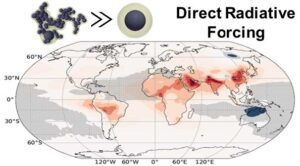Morphology, optical properties & climate impact of soot nanoparticles
Speaker: Dr. Georgios Anastasios Kelesidis - Rutgers University
Date: Dec 8, 2023; Time: 2:30 PM Location: UTEB 175
 Abstract: Soot is a major air pollutant produced by incomplete combustion of hydrocarbon fuels. The contribution of soot to global warming is currently estimated with large uncertainty (partly) due to the fractal-like agglomerate structure of its constituent nanoparticles. Here, the dynamics of soot nanoparticles are investigated to advance our current understanding of particle formation during combustion. Discrete element modeling (DEM) enables the detailed description of the particle morphology (doi.org/10.1016/j.proci.2016.08.078) and optical properties (doi.org/10. 1016/j.proci.2018. 08.025) in population balance models and computational fluid dynamics (doi.org/10.1016/j.combustflame.2021.01.010). Power laws relating the optical properties of soot to its filamentary structure are derived by DEM (doi.org/10.1016/j.carbon.2017.06.004) to facilitate the accurate monitoring of soot emissions by aerosol (doi.org/10.1016/j.proci.2020. 07.055), laser (doi.org/10
Abstract: Soot is a major air pollutant produced by incomplete combustion of hydrocarbon fuels. The contribution of soot to global warming is currently estimated with large uncertainty (partly) due to the fractal-like agglomerate structure of its constituent nanoparticles. Here, the dynamics of soot nanoparticles are investigated to advance our current understanding of particle formation during combustion. Discrete element modeling (DEM) enables the detailed description of the particle morphology (doi.org/10.1016/j.proci.2016.08.078) and optical properties (doi.org/10. 1016/j.proci.2018. 08.025) in population balance models and computational fluid dynamics (doi.org/10.1016/j.combustflame.2021.01.010). Power laws relating the optical properties of soot to its filamentary structure are derived by DEM (doi.org/10.1016/j.carbon.2017.06.004) to facilitate the accurate monitoring of soot emissions by aerosol (doi.org/10.1016/j.proci.2020. 07.055), laser (doi.org/10 .1016/j.combustflame.2022.112025) diagnostics and fire detectors (doi.org/10.1016/j.powtec.2019.02.003). Most importantly, these relations enable the estimation of the soot direct radiative forcing accounting for its realistic agglomerate structure (doi.org/10.1021/acs.est.2c00428).
.1016/j.combustflame.2022.112025) diagnostics and fire detectors (doi.org/10.1016/j.powtec.2019.02.003). Most importantly, these relations enable the estimation of the soot direct radiative forcing accounting for its realistic agglomerate structure (doi.org/10.1021/acs.est.2c00428).
Biographical Sketch: Dr. Georgios Kelesidis is an Assistant Professor at Rutgers School of Public Health and Deputy Director of the Nanoscience and Advanced Materials Center of the Environmental and Occupational Health Sciences Institute at Rutgers University. Prior to this appointment, he was a Lecturer and Research Associate at the Department of Mechanical and Process Engineering of ETH Zürich, Switzerland. He received a Diploma in Chemical Engineering from the University of Patras, Greece with honors (top 3%), along with the Limmat Stiftung Award of Academic Excellence (2013). His subsequent MSc studies in Process Engineering at ETH Zürich were supported by a Particle Technology Laboratory Fellowship (2013-2015), while his MSc thesis earned the IBM research prize (2017) for computer modelling and simulations in chemistry, biology and material science. His 2019 PhD thesis on the morphology and optical properties of flame-made nanoparticles received the 2020 PhD Award from GAeF (German Association for Aerosol Research) and the ETH medal for Outstanding Doctoral Thesis (top 8 %). He received also the 1st Graduate Student Award on Carbon Nanomaterials at the 2019 AIChE Annual Meeting (Orlando, FL, USA), as well as Best Poster Awards at the European Aerosol Conference (EAC) in 2016 (Tours, France) and 2020 (Aachen, Germany), the 2019 ETH Conference on Combustion Generated Nanoparticles (Zürich, Switzerland) and the 2019 Fall Meeting of the Material Research Society (MRS). The societal impact of his PhD research was also highlighted by the Forbes Magazine by including him in the 2020 Forbes 30 under 30 Europe list for Science & Healthcare. He has co-authored 21 peer-reviewed articles so far, being the first author in 16 of them. He has organized technical sessions at MRS (2016), EAC (2019-2021), the 2020-2022 Annual Meetings of the American Association for Aerosol Research, the 11th International Aerosol Conference (2022) and the 9th World Congress on Particle Technology (2022). He has supervised so far 10 MSc and 7 BSc students. He is currently co-supervising 1 PhD student at ETH Zürich.